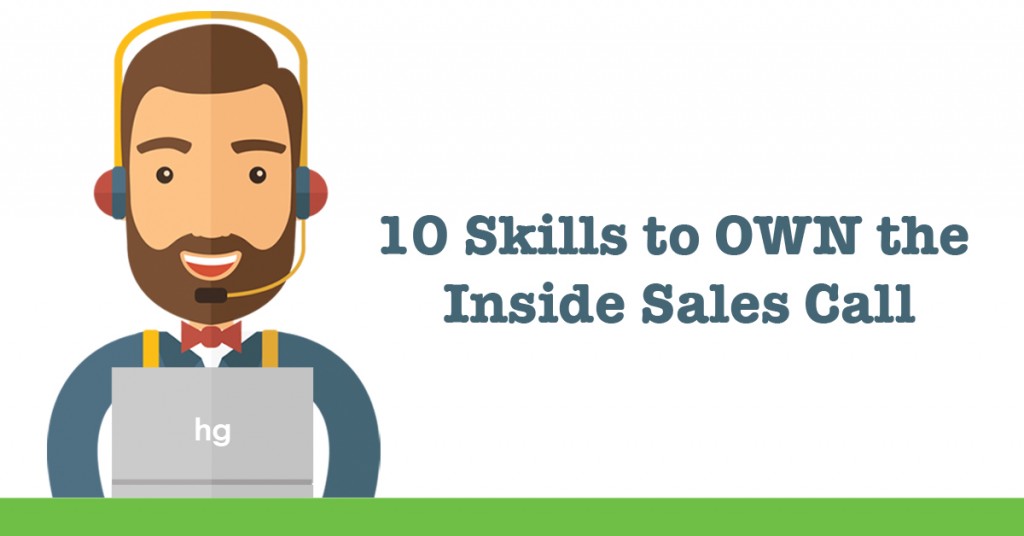Your Real Estate Skills Are Showing
We promised you a more comprehensive sequel to our 4 Keys to the Inside Sales Call with Chris Smith, one that concentrated on the skills you’ll need to be successful and close the deal. He absolutely nailed it, doling out indispensable info that couldn’t be missed! When we reached the end, however, we realized Chris had too many skills to fit into just one post. And because here at Happy Grasshopper we always keep our promises, we give you:

-
The Pre-Pitch Stalk
The more you know about a person, the easier it is to sell to them. This is an unavoidable truth whether you’re selling them a house or a Sno-Cone. Researching your lead is number 1 on this list and arguably the most important skill to hone.
Whether it’s Facebook, LinkedIn, or their website, information is power when it comes time for the call. Sites like www.charlieapp.com even present info about your lead on a one-page, easy-to-digest hot sheet to better prepare you. Knowing about the person you’re selling to not only leaves you poised to answer their questions, but also to stay ahead of any concerns they may have based on what you know about them. Stalk!
-
The Perfect First Minute
You have one minute to get the hook in and capture their attention – uno. While doing this is an understandably difficult task, it is made easier through the art of ARP’ing: Acknowledging, Repeating, and Pivoting. You want to:
- Acknowledge what the lead is looking for
- Repeat it back to them
- Pivot, and bring the conversation back to what it is you want to talk about
Acknowledging and repeating what the lead is inquiring about opens the opportunity to then bring the conversation back to your pitch. We all want to be heard, and not listening to your lead is the easiest way to lose the sale!
-
Dig Deep or Go to Sleep
The most important thing to note about this skill is that the close starts here – the jump-off point to your sale. Dig deep people! A potential buyer is selling their house – why are they selling the house? Oh, their kids have gone to college and they don’t need all the space – what colleges are they at? What are they studying? What kind of space are you looking for now?
These are all questions that evolve into sales on the phone if you ask them. If you don’t dig deep on the call and ask questions that keep the conversation going, you might as well go to sleep and call the sale a wash. The idea here is to form an emotional bond with your lead so that if they say no, they’re not saying no to you – they’re saying no to their dream of moving and what it means for them. Once you have them here, you have the sale.
-
How to Build Trust
We touched on this in our last post, but it’s important enough to repeat. If you want to be successful, you need to build trust – you do this by getting people to know you, like you, and trust you.
A great way to achieve this is by co-branding yourself with a service your lead trusts. In real estate, services such as Zillow and Yelp add that trust to your pitch. Saying something along the lines of: “I have over 1,000 five-star ratings on Zillow” attaches you to a service they know is solid and builds value to your pitch. When it comes to aligning yourself with another brand, you can get bitter or get better… so get better.
-
Proactively Uncovering Objections
Objections are an inevitability – they’re going to happen. The key to overcoming them isn’t to avoid them, but rather to meet them head-on, early, so you can get them out of the way and move forward with the sale. In our recent webinar on advanced lead conversion, Chris Smith of Curaytor spoke about how his service is a luxury that is not inexpensive. He explained that by tackling this issue early in the call, he could figure out whether or not his service was a good fit for his lead. If not, there’s no sense in wasting each other’s time in selling something that wasn’t going to happen.
Getting out in front of these objections will help you to either make the sale, or move on to someone who is a better fit.
-
How to Pitch (Feature + Benefit + Tie-Down = More Sales)
We’ve reached the pitch portion of our post – I’m sure we have all of your attention at this point! When it comes to pitching, you’ll want to give your potential client the feature, benefit, and tie-down.
Feature – This is where we explain what we for the customer
Benefit – This is where we go over how it benefits them
Tie-Down – This is where we solidify our point and drive the sale home.
Example:
“Hello! I just wanted to let you know that we work closely with Zillow (Feature), so we’re able to reach out to anyone who shows interest in your property within minutes (Benefit)! After all, that’s what you’re looking for in an agent, right (Tie-Down)?”
If you manage to incorporate those three elements into every sales call, not only will you help that lead see the value in your product/brand, but also how that value directly affects them.
-
Exactly When to Close
Now that you’ve isolated your features and benefits, it’s time for the most important aspect of the call: when to close the sale. In order to do this, you’re going to find the best feature/benefit you have in your back pocket and… hold on to it.
Yes, we said hold on to it.
You’re going to save the best for last, and let this final feature/benefit close your sale. Perhaps it’s that you can close homes faster and for more money than your competition – and you have the stats to prove it. Now is the time.. This last point needs to be the golden goose, the value your lead cannot ignore. Go get it!
-
The 5 Yes Technique
Earlier in the post, we asked you to dig deep; to keep asking questions, and learn the most you could about your potential client – now’s when you’re going to make those answers work for you. The 5 Yes Technique is designed to repeat what they told you, with the final question being: “Are we going to work together?”.
- So you’re looking for less space? Yes.
- Because you’re kids are off at college? Yes.
- Now, you’re looking for a condo? Yes.
- Somewhere near the water, right? Yes.
- Perfect! Let’s get you in the office and discuss our plan of action…
This solidifies why they are going to work with you, and that you completely understand their needs and are ready to go to bat for them.
-
How to Close (Trial and Slot Close)
Now that you have them right where you want them, it’s time for the trial and slot close. The trial close is designed to have the lead buy into the sale without being specific. This could be asking them what day of the week works best to meet – it helps them visualize that this is actually happening, and these are their options without hearing “No”.
The slot close is a definite close that is specific and outlines the final step. “Ok, so Tuesdays and Fridays are good days for you? Great, I have a 2pm on Tuesday and a 4pm on Friday – which one works best? Friday at 4pm? Perfect, here’s what happens next…”
10: Foreshadowing The Next Steps (Don’t Hit & Run)
Rookies end a call once they get a soft commitment – pros get a firm commitment. That’s the difference between being stood up on Friday at 4pm and finishing the deal. You can prevent losing that firm commitment by foreshadowing the next steps.
You want to let them know what the next step is, what you’re going to do for them, and what they have to look forward to – all while they sit back and relax as you work for them. You want the appointment to stick because without that appointment, you have nothing. You don’t want them to cancel or change their mind – foreshadow, reaffirm, and CRUSH it!

